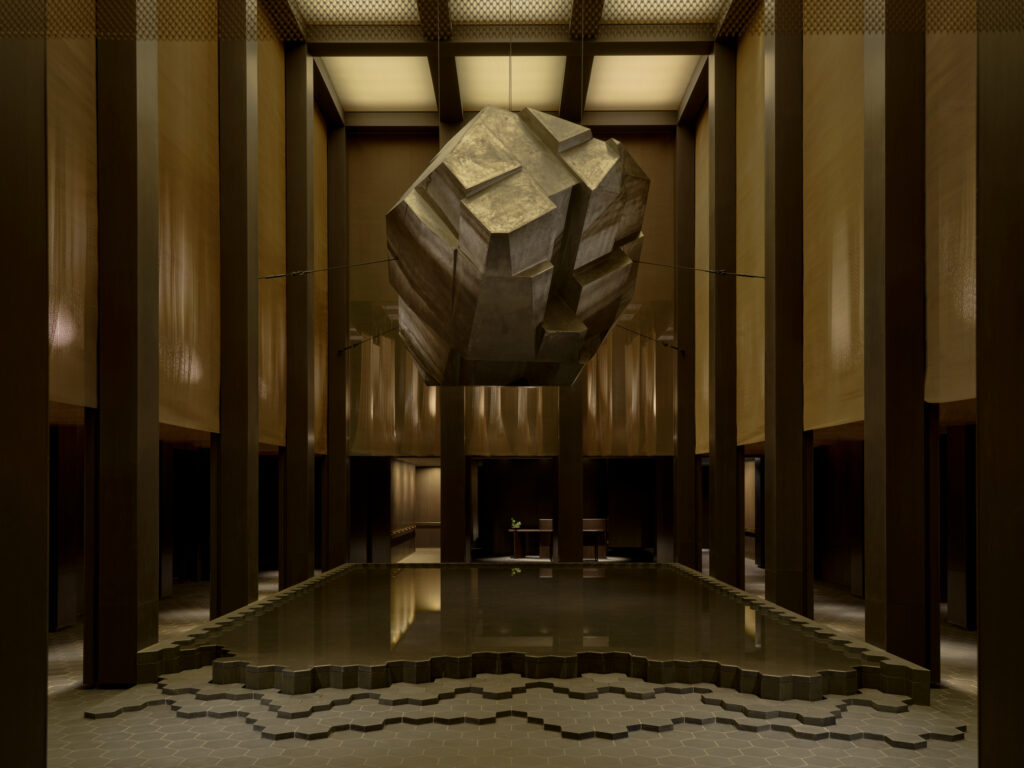Since George Yabu and Glenn Pushelberg founded their design firm 45 years ago, they have established themselves as leaders in Canadian and international interior design. Today, Toronto- and New York-based Yabu Pushelberg is renowned for sleek and innovative spaces like Toronto’s Four Seasons Hotel, La Samaritaine department store in Paris, the JW Marriott Hotel Tokyo, Raffles Sentosa Singapore and The Times Square EDITION, and for product collaborations with the likes of Nienkamper, Salvatori and Glas Italia.
The studio has been awarded numerous distinctions, including the AD 100 Hall of Fame, BoF 500, Design Studio of the Year Public Vote and Elle Décor A-List Designers. Yabu and Pushelberg received an honorary doctorate in interior design from Ryerson University (now Toronto Metropolitan University) and were inducted into the Order of Canada in 2014.
Yet the duo bring much more than design innovation to their community: they also give generously to the arts and to often-neglected healthcare causes. Over the years, their gifts have supported many exhibits at the Art Gallery of Ontario, and they have also supported less public but still vital causes like Casey House, a specialty hospital in Toronto for those living with or at risk of HIV, and Friends of Ruby, which supports 2SLGBTQIA+ youth (and for which Yabu Pushelberg designed the interiors).
Here, Yabu and Pushelberg share how they became friends in the 1970s (both are graduates of the interior design program at Toronto Metropolitan University, formerly Ryerson), how their global success hasn’t dimmed their creativity, and why pork buns from Toronto’s Chinatown will always have a special place in their hearts.
What memories of childhood stay with you as a designer now?
Glenn Pushelberg: I grew up in a modest, working-class family. My parents were factory workers, so design wasn’t something we talked about at home. But there was always making. My grandmother was a weaver, and my mother was constantly crafting. I remember being fascinated by proportion, the size of a cuckoo clock compared to a dishwasher. I didn’t know why that mattered, but it made me notice how things relate to one another.
George Yabu: My upbringing was similar. My father built wooden boats, and my mother was a seamstress. They were makers. My father even worked on the Meiji Shrine [in Tokyo] when he was young. There was always respect for craft and patience. Those values never left me. They shaped how I think about design today.
What was it like setting up your own design firm, and who helped you along the way?
Pushelberg: Neither of us set out to become designers, but we were both naturally curious and drawn more to creative work than academics. When we found a [university] program in interior design that allowed us to draw instead of writing exams, it felt right. We simply followed what we enjoyed.
At first, we had no idea how to run a business. We just wanted to design. Through trial, error, and a few financial scares, we learned the other side of it. Eventually, we even took a summer program at Harvard for architects and designers to understand how to make creativity sustainable.
Yabu: We were lucky to meet people who believed in us. [Architect] Arthur Erickson discovered our work early on and introduced us to people in the U.S. He became a mentor and friend. We also had business mentors who helped us make smarter decisions about growth and money. The key was realizing what we didn’t know and finding people who could teach us.

How did your parents guide you, but also allow for independent choices?
Pushelberg: We both had parents who gave us space. They didn’t push us toward traditional careers or put pressure on us to follow a specific path.
Yabu: That freedom made us want to prove ourselves. There was a quiet expectation to make our families proud, but they trusted us to find our own way. I think that independence made us both more self-reliant and curious.
When did design become a clear career path for you?
Pushelberg: It was always about joy. We didn’t set out with a plan—we just loved designing. When people said, ‘You need contacts,’ I took that literally. I realized you could find opportunities anywhere—the dry cleaner, the copy shop, the shoe store I worked in. Every place needed design help, and that’s how it began.
Yabu: We had no money. Lunch was 49-cent pork buns from Chinatown. But we didn’t care, we were excited. Every opportunity, no matter how small, was a chance to design and learn. We saw each project as a challenge: how do you make something ordinary feel human? That question drove us from the very beginning.
Pushelberg: Those early years were full of mistakes, but they were also full of joy and discovery. We learned by doing, and that shaped everything we became.
How did you become partners, and what challenges have you overcome despite your differences in personalities or artistry?
Pushelberg: We met in university, then later ran into each other on the street and decided to share a studio. That was the beginning.
Yabu: Like any relationship, business or personal, it’s had its challenges. But we’ve always had trust and respect. We see things differently sometimes, but those differences make the work stronger. We balance each other out.
What fuelled your passions around philanthropy?
Pushelberg: There comes a point in life when you have more than you ever imagined. Then you start thinking about what you can do with it that matters. For us, giving back felt natural. It’s part of who we are. It’s not just about money—it’s about time, care and creating opportunities for others.
Yabu: Money is just a marker. What matters is how you use it. We want to share what we have in ways that reflect our values and our gratitude for the life we’ve built.
How do you teach younger generations in your family about giving back?
Pushelberg: We think of family in a wide sense: it includes friends, colleagues and the people we work with.
Yabu: Giving isn’t only financial. It’s giving time, sharing advice, showing up. We try to lead by example. You don’t have to talk about values all the time; if you live them, people understand what matters to you.
What are your proudest memories?
Pushelberg: Casey House in Toronto is one that stays with us. As gay men who lived thorugh the AIDS crisis, we thought that chapter was behind us. But Casey House reminded us that HIV and AIDS are still real and still affect many people, especially women, children and people who are underserved.
Yabu: We licensed the work of [Indigenous artist] Ooloosie Saila and worked with RxArt in Canada to install it as wall coverings in the patient rooms at Casey House. For us, it tied together what matters most, giving visibility to an Indigenous artist, bringing art into a place of healing, and showing that design can make people feel seen.
Pushelberg: That project reminded us that design can heal. It’s not just about creating beautiful spaces; it’s about giving people comfort, dignity and hope.
Please visit here to see information about our standards of journalistic excellence.

